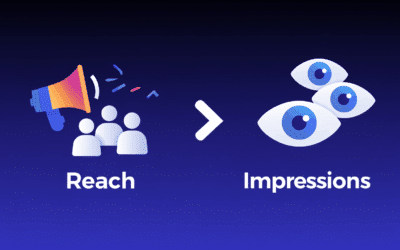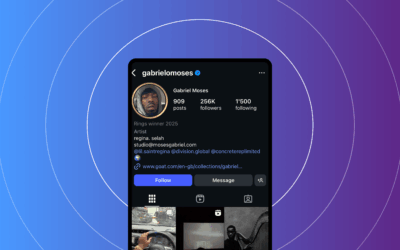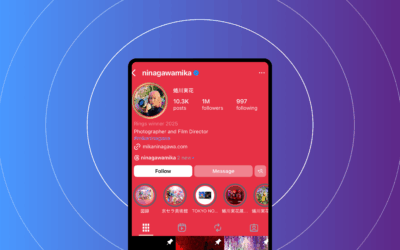Influencer marketing metrics: 7 Key numbers that spell success
Do you really want to succeed with influencer marketing?
Influencer marketing metrics are more than just important. They can make or break your campaign. 😱
At Click Analytic, we’ve discovered that keeping a keen eye on these metrics is essential for success.
Understanding and leveraging the right influencer marketing metrics can be the difference between a campaign that soars and one that stumbles.
Whether it’s about gauging engagement, measuring reach, or tracking conversions, each metric tells a story. And ultimately, your return on investment (ROI) depends on knowing these metrics. 📊
Let’s show you how to track these crucial influencer marketing metrics.
7 Metrics for influencer marketing

Fail to track these 7 metrics for influencer marketing, and you’re wasting your time and money. Let’s explain how to track these metrics and why they are crucial to your success.
1. Engagement rate
The engagement rate reflects how well an influencer can spark a conversation, ignite interest, and, essentially, resonate with their audience.
We’ve seen firsthand how a robust engagement rate can turn the tides in a marketing campaign, taking it from zero to hero.
What is the engagement rate?
The engagement rate measures audience interaction with an influencer’s content. This isn’t just about counting views. It’s about understanding how actively the audience participates in the conversation—through likes, comments, shares, and even saves.
Why does the engagement rate matter?
Well, in our experience, an influencer with a high engagement rate is akin to a magnet. They attract views and draw in an audience that listens, responds, and engages.
This is particularly crucial during a new product launch.
Imagine unveiling a new product and having it discussed, dissected, and celebrated across social platforms. That’s the power of high engagement.
💡 Example: Let’s paint a picture here. Consider a campaign promoting a groundbreaking eco-friendly sneaker.
An influencer posts about it, and the post doesn’t just gather views; it sparks a flurry of comments, shares, and discussions about sustainability in fashion. This is an example of a high engagement rate.
How do we track the engagement rate?
Now, onto the nitty-gritty. We typically measure the engagement rate over 10 to 30 posts. How do you measure this magic number?
Simply put, you can calculate the engagement rate by taking the total engagement (all those likes, comments, and shares) and dividing it by the total number of followers, then multiplying it by 100.
This percentage is a snapshot of the influencer’s ability to connect and engage with their audience.
For instance, if your campaign gathered 100 likes, 50 comments, and 10 shares among 200 followers, the formula for measuring engagement rate looks like this:
((100 + 20 + 10) / 200) x 100 = 65%
2. Reach and impressions

Reach and impressions are like twin stars, each shining light on different aspects of your influencer campaign’s visibility. Understanding these metrics is crucial in crafting an epic influencer marketing campaign.
What are reach and impressions?
Reach and impressions highlight distinct facets, though we often mention them simultaneously.
Reach tells you about the unique eyes that have seen your content, i.e., how many new people saw your content. Reach defines the breadth of your audience landscape.
On the other hand, impressions count how many times your content has appeared on someone’s screen, offering a glimpse into the frequency and pervasiveness of your message.
Why do reach and impressions matter?
We’ve learned that reach and impressions are vital in clearly portraying a campaign’s scope. For instance, if you’re launching a brand awareness campaign, prioritising high reach is like casting a wide net – you want to touch as many lives as possible.
Impressions, meanwhile, tell you if your content is just a passing cloud or a persistent presence in your audience’s daily social media scroll.
💡 Example: Imagine launching a campaign for a revolutionary skincare line. High reach means your campaign reaches a diverse and broad audience, which is essential for introducing a new product.
High impressions indicate that the content is reaching people and catching their attention repeatedly, reinforcing brand recognition.
How do we track reach and impressions?
You must use an influencer analytics platform or social media insights for measuring influencer marketing metrics. These tools offer precise data on both reach and impressions. You can then use this data to fine-tune your strategy to ensure your message lands across a broad audience and makes a lasting impression.
Of course, you could ask the influencer to send you screenshots with the stats, but who’s got time for that?
3. Conversion rate

The conversion rate helps us understand the actual effectiveness of our influencer marketing efforts. After all, we don’t just want to create a buzz; we want to turn that buzz into tangible results, like signups, products sold, and higher profits.
What is the conversion rate?
The conversion rate is a straightforward yet powerful metric. It represents the percentage of users who go beyond just viewing or liking content and take the action you desire, be it making a purchase, signing up for a newsletter, or downloading an app. This metric is the bridge between engagement and actual business results.
Why does the conversion rate matter?
In our experience, a high conversion rate is a clear indicator that the influencer’s content reaches the right audience and resonates with them to the point of action.
It’s the difference between someone just admiring your product and someone deciding to buy it.
💡 Example: Imagine an influencer promoting your latest book with a unique promo code. The conversion rate here would be the percentage of their followers who use that code to purchase your book. This helps you understand the real impact of your influencer partnerships in driving actions that matter to your brand.
How do we track the conversion rate?
So, how do we track this crucial metric? The key lies in using UTM parameters, promo codes or affiliate links. UTM parameters are tags added to the end of a URL, which help track the effectiveness of online marketing campaigns across traffic sources and publishing media.
They provide detailed insights into where your traffic is coming from, allowing you to see which influencer content is driving the most conversions.
You can optimise your campaigns for even better results by analysing where conversions are coming from.
4. Follower growth

The follower growth metric shows how your brand’s influence and appeal expand. It’s a metric that tells a story of connection and resonance.
What is follower growth?
This metric is direct yet profound. It measures the increase in the number of followers on a brand’s social media channels.
Why does follower growth matter?
We’ve seen that an uptick in followers often signals that an influencer amplifies your brand’s visibility and appeal.
It’s like watching your brand’s circle of friends grow. Each new follower represents a new potential advocate, customer, and part of your brand’s story.
💡 Example: Imagine collaborating with an influencer for a campaign to launch a new line of eco-friendly activewear. Post-campaign, you notice a significant spike in your follower count, growing from 1,000 to 3,500 followers. This is a sign that the influencer has successfully introduced your brand to a wider, receptive audience who are now intrigued and want to stay connected.
How do we track follower growth?
Tracking this metric is simple. It involves monitoring your follower count before and after the influencer campaign. This straightforward approach offers valuable insights into the impact of your influencer collaborations on your brand’s social media presence and audience growth.
5. Audience demographics and sentiments

Understanding audience demographics gives you an inside look at who’s engaging with the content and how they feel about it.
What are audience demographics and sentiments?
The audience demographic metric goes beyond surface-level metrics to delve into who the influencer’s audience really is. It’s an analysis that covers age, gender, location, interests, and more.
Sentiments towards the content are equally important, offering a window into how the audience perceives and reacts to the influencer’s posts. Do they like the content, or do they think it’s irrelevant?
Why do audience demographics and sentiments matter?
It’s one thing to have a large following; it’s another to have a following that aligns with your brand’s target market.
Understanding audience demographics and sentiments helps create content that speaks directly to the interests and needs of that audience. After all, you wouldn’t want to showcase high-end luxury watches to kids between 8 and 10, would you?
Demographics and sentiment are about making meaningful connections, not just casting a wide net.
💡 Example: Imagine partnering with an influencer for a campaign targeting young, environmentally conscious consumers. By analysing their audience demographics and sentiments, you ensure their followers match your target demographic and are positively receptive to sustainability-focused content. This alignment enhances campaign effectiveness and builds authentic connections with a relevant audience.
How do we track audience demographics and sentiments?
We turn to social listening tools and an influencer analysis platform to gather these insights. These tools provide detailed insights into audience composition and their sentiments.
By leveraging this data, you can fine-tune your strategy to ensure that your influencer partnerships hit the mark regarding audience relevance and engagement.
6. Content quality and relevance

Content quality and relevance are the secret spices that can elevate a campaign from good to unforgettable. This metric revolves around the artistry and appropriateness of the influencer’s content.
What is content quality and relevance?
This metric thoroughly evaluates the influencer’s content, focusing on its creativity, relevance, and how well it aligns with your brand’s values and message. It ensures the content doesn’t just grab attention but resonates and connects with the audience.
Why does content quality and relevance matter?
In our experience, high-quality and relevant content significantly influences how the audience perceives and engages with a brand.
It’s the difference between content that’s merely seen and content that’s remembered and acted upon.
When an influencer’s content blends their unique style with your brand’s essence, it creates a powerful synergy that captivates the audience.
💡 Example: Imagine working with an influencer crafting content for your line of artisanal coffees. The magic happens when they weave your products into their daily life stories, authentically showcasing their use. This approach highlights your product and tells a story their audience can relate to and be inspired by.
How do we track content quality and relevance?
You can track content quality and relevance through qualitative analysis and audience feedback. Use surveys and interviews to gather this data.
Listen to what the audience is saying in comments, gauge their reactions, and assess how well the influencer’s creativity and message align with your brand values.
7. Cost per engagement (CPE)

You must keep a keen eye on the economics of your campaigns. This is where the cost per engagement (CPE) comes into play, serving as a crucial gauge of your investment’s effectiveness.
What is the cost per engagement?
CPE is a metric that measures the cost-effectiveness of your influencer marketing efforts. We calculate it by dividing the total cost of an influencer campaign by the total number of engagements (likes, comments, shares) the content receives. It tells you how much you pay for each interaction your campaign generates.
Why does cost per engagement matter?
The importance of CPE lies in its ability to offer a clear picture of the return on your investment.
Sadly, not all partnerships are created equal.
Some may seem affordable but yield low engagement. In contrast, others might be more expensive but generate a high level of interaction. Understanding CPE helps you navigate these waters, ensuring you use your budget effectively to engage your target audience.
💡 Example: Let’s say you’re considering two influencers for a campaign. One has a lower fee and engagement rates, while the other charges more but has a highly engaged audience. By calculating the CPE for both, you can determine which influencer provides the best value for your investment.
How do we track cost per engagement?
Calculating CPE is straightforward. Simply divide the total cost of your campaign by the total engagements it garners.
This calculation gives you a tangible figure to work with, helping you to make informed decisions about future influencer partnerships and budget allocations.
For example, if your campaign costs $500 and you gained 2,500 engagements, the formula looks like this:
$500 / 2,500 = $0.02 cost per engagement.

Conclusion
Mastering influencer marketing metrics is critical to navigating the complex yet rewarding world of digital influence.
Each metric offers a unique lens through which the success and impact of your influencer campaigns can be evaluated and optimised.
Remember, the journey doesn’t end with data collection. Use these insights to shape your strategies. An effective influencer analysis tool can be your ally in this process, transforming raw data into actionable intelligence.
Influencer Marketing Articles
Actionable tips to get more success with influencer marketing campaigns
Reach vs Impressions: What’s the Difference (and Why It Matters)
If you’ve ever looked at a campaign report and wondered why impressions are higher than reach, you’re not alone... The difference between Reach vs Impressions is one of the most misunderstood topics in marketing 🤔 Yet understanding Reach vs Impressions directly...
Who is Gabriel Moses?
Discover Gabriel Moses, the London-born artist blending fashion, music, and heritage into striking visual narratives. From Dior to Johnnie Walker, see why he’s shaping culture.
Who is Mika Ninagawa?
Discover Mika Ninagawa, Tokyo’s visionary photographer and film director celebrated for her vivid art, bold storytelling, and win at Instagram Rings 2025.






